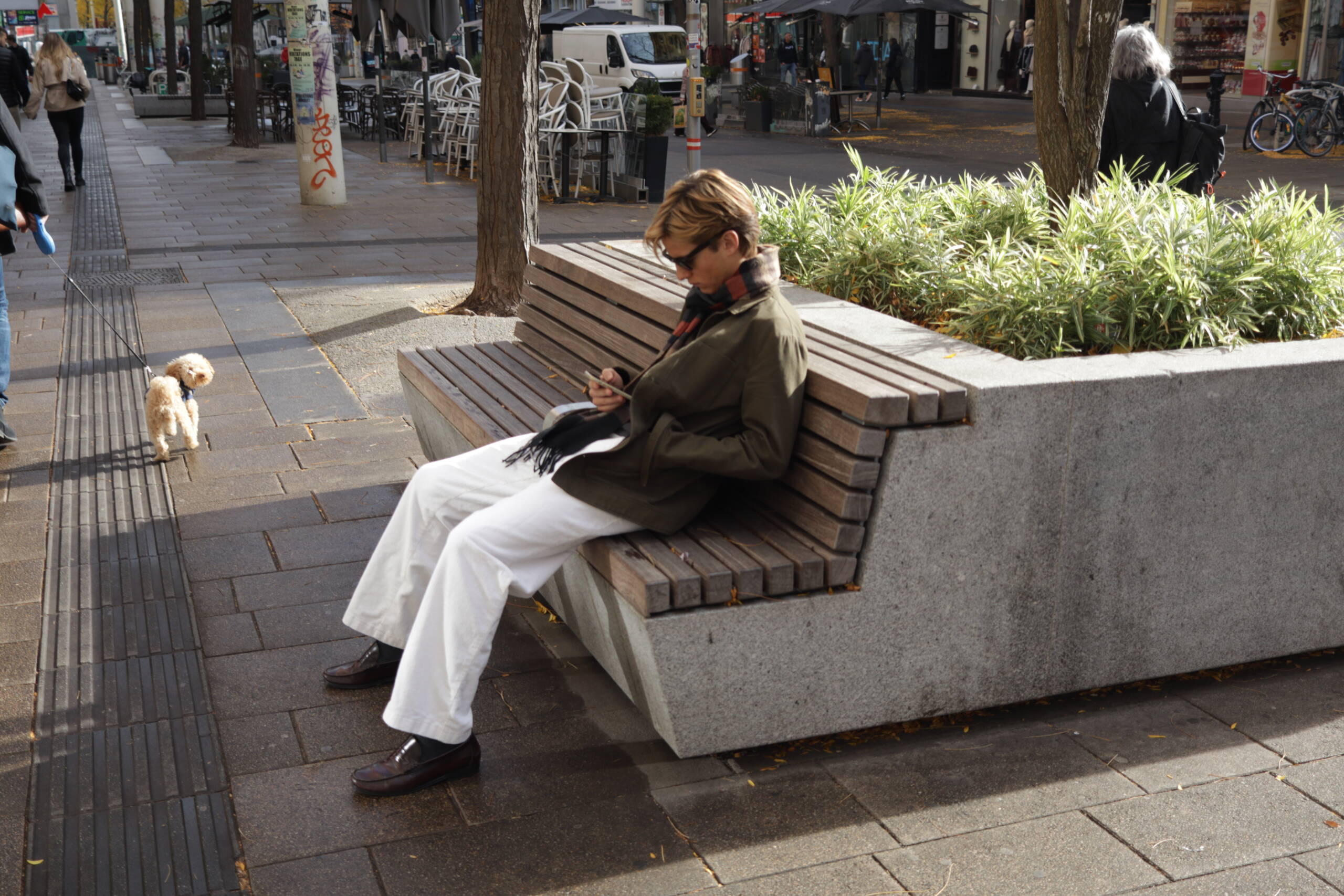Effortless Autumn Layers: A Lesson in Quiet Street Style
There’s an undeniable charm in effortless dressing—the kind that doesn’t try too hard yet leaves a lasting impression. This photograph captures that exact essence. A man sits casually on a wooden bench along a tree-lined city street, sunlight washing over his jacket while the pavement glows faintly with late autumn warmth. Around him, the world continues in motion: a passerby walking a small dog, bicycles resting near shopfronts, and the faint hum of midday traffic. Yet he sits there, calm and absorbed, his style quietly commanding the scene without demanding attention.

He wears what at first seems like a simple outfit: an olive-green jacket, a black scarf, crisp white trousers, and polished brown leather shoes. But look a little closer, and you realize this is not just simplicity—it’s intention. Each piece is balanced in color, texture, and proportion. It’s the kind of outfit that says more about confidence than about fashion itself. There’s no logo, no flashy design, no exaggeration—just a collection of high-quality staples that age gracefully and blend seamlessly into everyday life.
The olive-green jacket is the cornerstone here, structured yet relaxed, sitting somewhere between a field jacket and a tailored overshirt. The material seems to be a cotton twill or waxed canvas—functional, slightly rugged, but incredibly elegant in daylight. Olive green has always been a bridge between utility and sophistication; it pairs easily with neutrals and never feels out of place in the city. Under sunlight, the tone deepens into bronze; in shadow, it softens into khaki. That versatility is exactly why it works so well. Brands like Barbour and Belstaff built entire legacies on this kind of outerwear, while more modern labels like Asket, Arket, or COS continue to refine it with cleaner silhouettes and sustainable materials.
Then come the trousers—loose, wide-legged, and strikingly white. Wearing white pants in autumn is a small act of rebellion against the season’s expected darkness. It’s a look that risks impracticality but pays off in freshness. The cut is straight and fluid, not stiff. When combined with the olive jacket, the result is both crisp and relaxed—a sign of someone who knows how to blend structure with comfort. The wide-leg silhouette also signals a subtle return to vintage tailoring, reminiscent of 1970s European menswear but reinterpreted for modern life. You can find similar styles at A.P.C., Officine Générale, or even Uniqlo U, where proportions are relaxed but refined.
His scarf anchors the upper half of the outfit—a loosely draped black wool or cashmere scarf, possibly with faint plaid accents. It isn’t fussed over; it’s just there, worn as naturally as one wears a habit. It frames the face, softens the collar line, and gives texture against the flatness of the jacket. A scarf like this can transform an outfit from ordinary to memorable with minimal effort. You can look to Acne Studios, Johnstons of Elgin, or Everlane for versions that capture this kind of understated luxury.
Down at street level, his footwear completes the picture. Brown leather shoes—sleek, durable, and unmistakably European—ground the entire outfit. The hue of the leather is deep and warm, contrasting gently with the white trousers. Their design is practical yet elegant, something between a derby and a moc-toe. It’s a shoe that says “city walker” more than “office commuter.” The craftsmanship stands out quietly; these are the kind of shoes that get better with time, developing that lived-in sheen of real quality. Church’s, Crockett & Jones, or Meermin Mallorca produce almost identical silhouettes, while Velasca Milano or Nisolo offer equally stylish modern versions for daily wear.
His sunglasses—black-framed and discreet—finish the ensemble with a note of composure. They don’t shout, they settle. There’s a touch of anonymity in them, that timeless movie-like presence you get from Ray-Ban Clubmasters or Oliver Peoples Cary Grant frames. And then there’s the smartphone in his hand, the small but telling symbol of modern life that ties the whole scene to now. He’s not performing for anyone; he’s simply existing, checking messages, scrolling through something on a quiet afternoon.
What makes this outfit so compelling is the way it interacts with its surroundings. The urban palette of greys, browns, and greens echoes through the clothes. The texture of the pavement mirrors the matte finish of the jacket. Even the faint autumn leaves scattered near his shoes complement the white fabric of his trousers. This harmony between style and setting is what street fashion, at its best, truly means. It’s not about standing out—it’s about belonging, effortlessly.
There’s a story behind looks like this. It suggests someone comfortable in his own rhythm, someone who values quality over novelty. The fit is intentional but never rigid. The combination of olive, white, brown, and black feels both timeless and seasonal. The layers move with him; they don’t confine him. It’s modern European style in its purest form—functional, minimal, slightly intellectual, but always human.
To recreate this look, don’t overthink it. Start with a field jacket or cotton overshirt in olive green, slightly relaxed in cut. Add a pair of wide-leg white trousers—chino fabric works best for movement. Choose brown leather shoes that are comfortable for walking and a black wool scarf for contrast. Finally, wear dark sunglasses that frame your face without drawing too much attention. It’s a look built not on trend but on quiet consistency, a kind of wardrobe philosophy that outlives seasons.
This is fashion in its calmest form: streetwear that doesn’t announce itself, but lingers in memory because it feels so right. The sunlight, the bench, the ease—all of it combines into a portrait of modern simplicity. It’s a reminder that true style isn’t loud or complicated. Sometimes, it’s just someone sitting comfortably in their clothes, at peace with the world passing by.